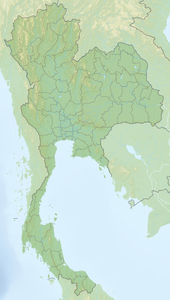Ko Phi Phi Don
| Ko Phi Phi Don | ||
|---|---|---|
| Beach on Ko Phi Phi Don | ||
| Waters | Andaman Sea | |
| Archipelago | Phi Phi | |
| Geographical location | 7 ° 44 '36 " N , 98 ° 46' 32" E | |
|
|
||
| length | 7.5 km | |
| width | 4 km | |
| surface | 28 km² | |
| View from the isthmus of the rugged cliffs | ||
Ko Phi Phi Don ( Thai : เกาะ พี พี ดอน ) is the largest island in the Thai Phi Phi archipelago (Mu Ko Phi Phi - หมู่ เกาะ พี พี ). It belongs to the southern Thai province of Krabi and is the only permanently inhabited island in the group.
geography
Like the other islands in the group, the 28 square kilometer Ko Phi Phi Don is not of volcanic origin and consists mainly of limestone . It consists almost of two islands, which are however connected to each other by a narrow isthmus . The largest town on the island is on this strip, as are most of the hotels.
Villages
- Laem Tong ( แหลม ต ง ), a cape at the northern tip, around 15 to 20 Moken families still live here , who were resettled here from Ko Li Pe ( เกาะ ลิ เป๊ะ , Satun Province ).
- Has Lanti, mainly inhabited by Muslims who were able to successfully assert themselves against the development of a tourist infrastructure.
- Ban Ton Sai,
- Has Yao,
- Ao Lo Dalam.
tourism
Tourists from all over the world (especially from Europe, Japan and the richer Southeast Asian countries) flock to the island. It can be easily reached by boat from Phuket and the mainland ( Krabi Province ) (the crossing from Phuket takes about 1.5 hours). Today parts of the island (especially the area around Tonsai Bay) are developed for tourism. Restaurants , shops and internet cafes are plentiful.
ecology
Although the island has been part of the Hat Noppharat Thara - Mu Ko Phi Phi Marine National Park ( อุทยานแห่งชาติ หาด นพรัตน์ ธารา - หมู่ เกาะ พี พี ) since 1983, little is being done about the island's wild vegetation or the destruction of the reefs. In addition, some areas of the famous beaches are littered with litter, mostly in the form of cans or plastic bags . However, since Ko Phi Phi Don became so popular with divers and snorkelers , the locals have given up dynamite fishing and other harmful activities that may threaten the reefs.
Although more conservation measures are needed, Ko Phi Phi Don is still an impressive island with its lush limestone cliffs, a viewpoint and clear water.
Tsunami
As a by the Indian Ocean tsunami in 2004 incurred tsunami on 26 December 2004, the island reached 700 people died. Lo Dalam Bay was hit hardest and most of the bungalows and restaurants on the beach were destroyed.




